I think about historical plausibility a lot. Historical costumers worry about accuracy, but I think that ‘accurate’ often gets confused with ‘common’. Just because most seamstresses did something one way, doesn’t necessarily mean that one or two might not have done it completely differently.
Lots of things happen today that aren’t mainstream. Even with the plethora of information on the internet today, people sew, and create, and live in ways that aren’t documented. It is reasonable to assume that historically, there were also seamstresses who created in unusual ways, and used unusual materials.
The costumer who asked me about 18th century masquerade outfits also asked about ideas for making her dress on a limited budget.
I’ve been turning the question over in my mind, and last night (well, 4am in the morning) I had an epiphany. Why not use muslin/calico?
Raw, unpatterned cotton calico (which American’s call muslin) existed in late 18th century Europe. In fact, huge amounts of it were imported, because many countries had passed laws making it illegal to import patterned calico from India in order to protect their own textile industries.
Most 18th century masquerade dresses were just formal dresses, trimmed to represent the idea, allegory, or personage the reveler wanted to dress as. But some people did have specific masquerade outfits made.
Based on extent examples, most formal 18th century frocks were silk. But, that doesn’t mean that the occasional partygoer didn’t use the excuse of the informality of the masquerade as an opportunity to wear a cotton frock.
I’m sure that the chemise a la reine of the sleepy partygoer above was made of cotton!
I also know of one late 18th century beauty who was the belle of the ball at an international soiree in Germany in a dress of a most unusual material (basically paper) which she described as being styled in the mode of a shepherdess.*
So, with all this in mind, I think it is entirely plausible that there could have been 18th century masquerade dresses made of unpatterned Indian calico. And I think that a costumer on a budget who finds the idea appealing shouldn’t hesitate to make one!
And finally, just some more 18th century masquerade scenes that I have found:

Rosalba Carriera. Gustavus Hamilton (1710—1746), Second Viscount Boyne, in Masquerade Costume, 1731-32
Luxurious masquerade costume for an early 18th century gentleman. Don’t you love his lace veil?
The moon and stars in her hair indicate she may be Diana. I can’t figure out the thing on her skirt.
A not so flattering depiction of masquerade-goers.
It’s not clear if this painting is meant to represent a real country dance, or masquerade revelers dressed as charmingly bucolic country folk.
Another slightly ambiguous Watteau inspired scene. Are they masqueraders or not?
Very traditional Carnivale inspired costumes, along with a smattering of Ottomans and shepherdesses, are the order of the day in this depiction of a mid-century ball in Bohemia. Click on the image to be taken to the Met’s site, where you can see more of it detail.
The vignettes in this scene of the famous Venetian Ridotto gambling house and masquerade venue are just adorable:
*I’m planning a project based on the incident, so I don’t want to share too much of my scholarship around it yet.



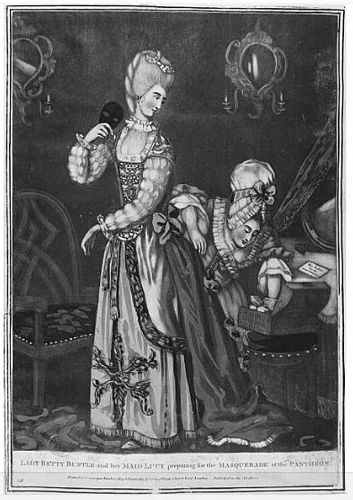
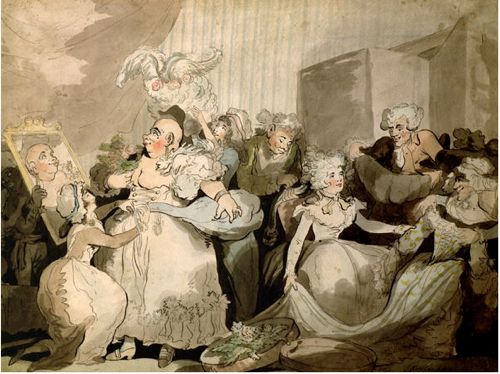




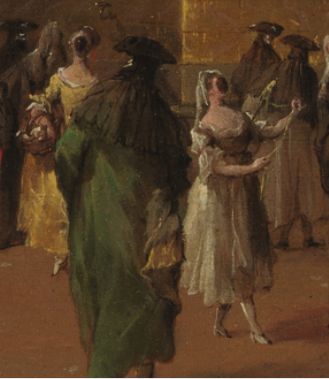
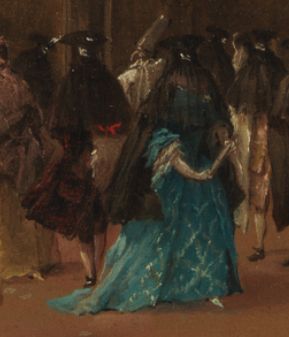
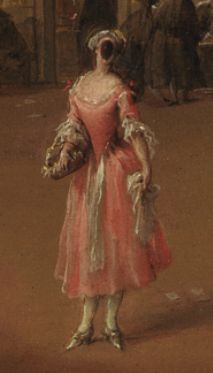

There’s always a tension for historical reenactors and other historical costumers between the documentable and the plausible. There are many things that are plausible, given a period’s technology, that likely were not done (say, because they clashed with the prevalent fashion aesthetic). On the other hand, many reenactors assume that what can be documented is necessarily common, and that’s not always the case (particularly for periods in which surviving garments or even fabric finds are scarce). Naturally, every costumer/scholar resolves this conflict in a different way, and most fiercely defend their position against conflicting views.
Sigh.
Seems to me that in a world where there was no internet, phone or fast means of travel and a person may live their entire life in a ten mile radius, variation would have been far greater than it is now. This definitely applies to spelling conventions, and weaving techniques, so why not to methods of construction and choice of material? I think extant pieces give us a skewed view of a period anyway – they survived when 99.999% of clothing didn’t because, likely, they were so very posh! 🙂
Excellent questions (and more fabulous pictures!). This is the kind of question I’ve grappled with a lot since taking over the “inspection” gig of our reenacting organization (it’s the kind of job that you get if you pop up to use the loo at the wrong time–you come back to find out you’ve been volunteered. Aaack). For me, a lot of it comes down to the goal of the individual–if she wants to be as accurate as possible, I’d advise against using cotton–simply because we can’t document it 100%. (Alternately, I often advise people to dig deeper in the documentation if they’re smitten with an iffy idea–and they come up with the coolest things!) But if she’s ok with wiggle room? Well, if finer gowns were occasionally made of cotton, and a masquerade gown is simply a decorated fancier gown, and a=b=c…why not?
I’ve had friends who preferred to use synthetics because they more closely approximated the look of the original silk they wanted to imitate without going broke finding the “right” silk. I prefer to stick with the authentic fabrics, but again–it’s a personal preference/goal thing. Ultimately, I’m a reenactor, not a costumer–so my priorities are a little skewed.
Of course, part of my favorite part of sewing on a budget is scrounging fabric…so don’t forget the thrill of the silk hunt if she chooses to go that route!!